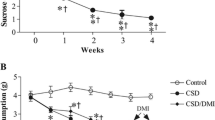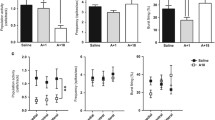Abstract
Different types of clinically effective antidepressants prevent the behavioral effects of experimental stress, and some of these treatments affect mesolimbic dopamine (DA) functioning. Animal studies have demonstrated that repeated psychostimulant administration and repeated or chronic stressful experiences also affect mesolimbic DA functioning. These results could suggest homologies among stress, psychostimulants and antidepressants. The present experiments show that either repeated stress (120min restraint daily for 10 consecutive days) or subchronic treatment with the antidepressant minaprine (5 mg/kg daily for 10 consecutive days) significantly reduced the inhibitory effect of 120 min of restraint on climbing, a behavioral response dependent on mesolimbic DA functioning. However, the antidepressant did not induce the altered sensitivity of presynaptic DA receptors promoted by repeated stress. Chronic stressful experience (13 days of food restriction) and repeated amphetamine (2.5 mg/kg daily for 10 consecutive days) were as effective as subchronic minaprine in reducing immobility in the Porsolt's swimming test. However, whilst both stress and amphetamine enhanced struggling, minaprine promoted swimming. Finally, chronically stressed mice and mice pretreated with amphetamine showed enhanced sensitivity to amphetamine-induced locomotion, whilst this effect was absent in animals pretreated with the antidepressant. These results indicate that although chronic and repeated stress as well as amphetamine have some antidepressant-like behavioral effects, their mode of action could be different from that of clinically active substances.
Similar content being viewed by others
References
Anisman H, Zacharko RM (1990) Multiple neurochemical and behavioral consequences of stressors: implications for depression. Pharmacol Ther 46:119–136
Antelman SM, Chiodo LS (1983) Amphetamine as a stressor In: Creese I (ed) Stimulants: neurochemical, behavioral and clinical perspectives. Raven Press, New York, pp 269–299
Armario A, Gil M, Marti J, Pol O, Balash J (1991) Influence of various acute stressors on the activity of adult male rats in a holeboard and in the forced swim test. Pharmacol Biochem Behav 39:373–377
Badiani A, Cabib S, Puglisi-Allegra S (1992) Chronic stress induces strain-dependent sensitization to the behavioral effects of amphetamine in the mouse. Pharmacol Biochem Behav 43:53–60
Bidzinska EJ (1984) Stress factors in affective disorders. Br J Psychiatry 144:161–166
Biziere K, Kan J-P, Souilhac J, Muyard JP, Roncucci R (1982) Pharmacological evaluation of minaprine dihydrochloride, a new psychotropic drug. Arzneimittelforschung 32:824–831
Biziere K, Worms P, Kan J-P, Mandel P, Garattini S, Roncucci R (1985) Minaprine, a new drug with antidepressant properties. Drugs Exp Clin Res 11:831–840
Borsini F, Meli A (1988) Is the forced swimming test a suitable model for revealing antidepressant activity? Psychopharmacology 94:147–160
Cabib S, Puglisi-Allegra S (1991) Genotype-dependent effects of chronic stress on striatal and mesolimbic dopamine metabolism in response to apomorphine. Brain Res 542:91–96
Cabib S, Puglisi-Allegra S (1994) Opposite responses of mesolimbic dopamine system to controllable and uncontrollable aversive experiences. J Neurosci 14:3333–3340
Carlsson A (1975) Dopaminergic autoreceptors. In: Almgren O, Carlsson A, Engel L (eds) Chemical tools in catecholamine research, vol. 2 North Holland Publishing Co. New York, pp 49–65
Chiodo LA, Antelman SM (1980) repeated tricyclics induce a progressive dopamine autoreceptors subsensitivity independent of daily drug treatment. Nature 287:451–454
Clark D, White FJ (1987) D1 dopamine receptors-the search for a function: a critical evaluation of the D1/D2 dopamine receptors classification and its functional implications. Synapse 1:347–388
Corwell DG, Milden RS, Shimp A (1985) Stressful life events associated with endogenous depression. J Nerv Ment Dis 173:470–476
Costall B, Fortune DH, Naylor RJ, and Nohria V (1980) The mesolimbic system, denervation and the climbing response in the mouse. Eur J Pharmacol 66:207–215
Costall B, Naylor RJ, Nohria V (1981) Use of the intracerebral injection technique to elucidate mechanisms of apomorphine climbing and its antagonism in the mouse. Psychopharmacology 73:91–94
Delini-Stula A, Radeke E, Van Rieze H (1988) Enhanced functional responsiveness of the dopaminergic system: the mechanism of anti-immobility effects of antidepressants in the behavioral despair test in the rat. Neuropharmacology 27:943–947
Deroche V, Piazza PV, Casolini P, Le Moal M, Simon H (1993) Sensitization to the psychomotor effects of amphetamine and morphine induced by food restriction depends on corticosterone secretion. Brain Res 611:352–356
Hilakivi LA, Ota M, Lister RG (1989) Effects of isolation on brain monoamines and the behavior of mice in tests of exploration, locomotion, anxiety and behavioral “despair”. Pharmacol Biochem Behav 33:371–374
Imperato A, Obinu MC, Cabib S, Cestari V, Puglisi-Allegra S (1994) Effects of subchronic minaprine on dopamine release in the ventral striatum and on immobility in the forced swimming test. Neurosci Lett 166:69–72
Kalivas PW, Stewart J (1991) Dopamine transmission in the initiation and expression of drug- and stress-induced sensitization of motor activity. Brain Res Rev 16:223–244
Klimek V, Nielsen M (1987) Chronic treatment with antidepressants decreases the number of3(H)SCH 23390 binding sites in the rat striatum and limbic system. Eur J Pharmacol 139:163–169
Maj J, Wedzony K (1985) Repeated treatment with imipramine or amitriptyline increases the locomotor response of rats to (+)-amphetamine given in the nucleus accumbens. J Pharm Pharmacol 37:362–364
Maj J, Rogoz Z, Skuza G, Sowinska H (1984) Repeated treatment with antidepressant drugs increases the behavioral response to apomorphine. J Neural Transm 60:273–282
Marcais H, Protais P, Costentin J, Schwartz JC (1978) A gradual score to evaluate the climbing behaviour elicited by apomorphine in mice. Psychopharmacology 56:233–234
Martin-Iverson M, Leclere JF, Fibiger HC (1983) Cholinergic-dopaminergic interactions and the mechanism of action of anti-depressants. Eur J Pharmacol 94:193–201
Martres MP, Costentin J, Baudry M, Marcais H, Protais P, Schwartz JC (1977) Long term changes in the sensitivity of pre-and postsynaptic dopamine receptors in the mouse striatum evidenced by behavioral and biochemical studies. Brain Res 136:319–337
Montgomery SA, Baldwin DS, Priest RG, Steinert J, Patel A, Herrington RN, Livingston HM (1991) Minaprine dose response in depression. An investigation of two fixed doses of minaprine compared with imipramine. Pharmacopsychiatry 24:168–174
Muscat R, Towell A, Willner P (1988) Changes in dopamine autoreceptor sensitivity in an animal model of depression. Psychopharmacology 94:545–550
Muscat R, Sampson D, Willner P (1990) Dopaminergic mechanism of imipramine action in an animal model of depression. Biol Psychiatry 28:223–230
Papp M, Klimek V, Willner P (1994) Parallel changes in dopamine D2 receptor binding in limbic forebrain associated with chronic mild stress-induced anhedonia and its reversal by imipramine. Psychopharmacology 115:441–446
Platt JE, Stone EA (1982) Chronic restraint stress elicits a positive antidepressant response on the forced swim task. Eur J Pharmacol 82:179
Plaznik A, Kostowsky W (1987) The effects of antidepressants and electroconvulsive shocks on the function of the mesolimbic dopamine system: a behavioral study. Eur J Pharmacol 135:152–158
Prince CR, Anisman H (1984) Acute and chronic stress effects on performance in a forced-swim test. Behav Neural Biol 42:99–119
Puglisi-Allegra S, Kempf E, Cabib S (1990) Role of genotype in the adaptation of the brain dopamine system to stress. Neurosci Biobehav Rev 14:523–528
Puglisi-Allegra S, Imperato A, Angelucci L, Cabib S (1991) Acute stress induces time-dependent responses in dopamine mesolimbic system. Brain Res 554:217–222
Puglisi-Allegra S, Cabib S, Cestari V, Castellano C (1994) Post-training minaprine enhances memory storage in mice: involvement of D1 and D2 dopamine receptors. Psychopharmacology 113:476–480
Robinson TE (1988) Stimulant drugs and stress: factors influencing individual differences in the susceptibility to sensitization. In: Kaliva PW, Barnes C (eds) Sensitization of the nervous system. Telford Press, Caldwell, N.J., pp 145–173
Robinson TE, Berridge KC (1993) The neural basis of drug craving: an incentive-motivation theory of addiction. Brain Res Rev 18:247–292
Rossetti ZL, Lai M, Hmadan Y, Gessa GL (1993) Depletion of mesolimbic dopamine during behavioral despair: partial reversal by chronic imipramine. Eur J Pharmacol 242:313–315
Serra G, Argiolas A, Klimek V, Fadda F, Gessa GL (1979) Chronic treatment with antidepressants prevents the inhibitory effects of small doses of apomorphine on dopamine synthesis and locomotor activity. Life Sci 25:415–424
Serra G, Collu M, D'Aquila PS, de Montis GM, Gessa GL (1990) Possible role of dopamine D1 receptor in the behavioral subsensitivity to dopamine agonists induced by chronic treatment with antidepressants. Brain Res 527:234–243
Swerdlow RN, Koob GF (1987) Dopamine, schizophrenia, mania, and depression: toward a unified hypothesis of cortico-striatopallido-thalamic function. Behav Brain Sci 10:197–245
Weiss JM, Goodman PA, Losito BG, Corrigan S, Charry JM, Bailey WH (1981) Behavioral depression produced by an uncontrollable stressor: relationship to norepinephrine, dopamine, and serotonin levels in various regions of rat brain. Brain Res Rev 3:167–205
Wheatly D (1992) Minaprine in depression. A controlled trial with amitriptyline. Br J Psychiatry 161:113–115
Willner P (1983) Dopamine and depression: a review of recent evidence. Brain Res Rev 6:211–246
Willner P (1991) Animal models as simulations of depression. Trends Neurosci 121:131–136
Willner P, Montgomery A (1981) Behavioral changes during withdrawal from the tricyclic antidepressant desmethylimipramine (DMI) I. Interaction with amphetamine. Psychopharmacology 75:54–59
Zacharko RM, Anisman H (1991) Stressor-induced anhedonia and the mesocorticolimbic system. Neurosci Biobehav Rev 15:391–405
Author information
Authors and Affiliations
Rights and permissions
About this article
Cite this article
Cabib, S., Zocchi, A. & Puglisi-Allegra, S. A comparison of the behavioral effects of minaprine, amphetamine and stress. Psychopharmacology 121, 73–80 (1995). https://doi.org/10.1007/BF02245593
Received:
Revised:
Issue Date:
DOI: https://doi.org/10.1007/BF02245593




